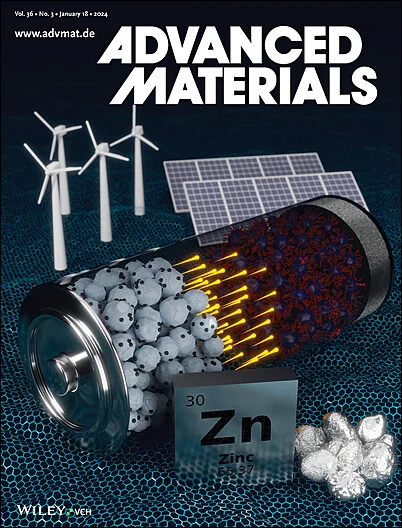1D Van Der Waals Superlattices for Polarization-Sensitive Photodetectors.
IF 26.8
1区 材料科学
Q1 CHEMISTRY, MULTIDISCIPLINARY
引用次数: 0
Abstract
The ability to detect polarimetric information of light over a broad spectra range is central to practical optoelectronic applications and has been successfully demonstrated with photodetectors of low-symmetry 2D van der Waals materials (vdWMs). However, polarization sensitivity within such a photodetectors remains elusive due to the limited diversity. To address this challenge, an approach is proposed by transforms 2D Lead iodine (PbI2) into 1D superlattice microwires (SLMs) through a solution-phase antisolvent diffusion method. This structural shifting enables the creation of low-symmetry crystal characteristics, a well-defined geometric microcavity structure, and an increased bandgap, which collectively confer anisotropic waveguide properties across visible and near-infrared wavelengths. By integrating PbI2 SLMs with isotropic 2D vdWMs, that waveguide-integrated photodetectors are demonstrated capable of polarization detection, achieving linear dichroism ratio (LDR) values of 1.66 at 405 nm for PbI2 photodetectors and 1.73 at 785 nm for WSe2 photodetectors. This paradigm-shifting strategy enables polarimetric information detection using isotropic vdWMs and advances the development of next-generation polarization-resolved optoelectronic devices.偏振敏感光电探测器的一维范德华超晶格。
在宽光谱范围内检测光的偏振信息的能力对实际光电应用至关重要,并且已经成功地用低对称二维范德华材料(vdWMs)的光电探测器进行了演示。然而,由于多样性有限,这种光电探测器的偏振灵敏度仍然难以捉摸。为了解决这一挑战,提出了一种通过液相反溶剂扩散方法将二维碘铅(PbI2)转化为一维超晶格微线(slm)的方法。这种结构位移使得低对称性晶体特性、明确的几何微腔结构和增加的带隙成为可能,这些特性共同赋予了波导在可见光和近红外波段的各向异性特性。通过将PbI2 slm与各向同性二维vdwm集成,证明了该波导集成光电探测器能够进行偏振检测,PbI2光电探测器在405 nm处的线性二色比(LDR)为1.66,WSe2光电探测器在785 nm处的线性二色比(LDR)为1.73。这种范式转换策略使得使用各向同性vdwm的偏振信息检测成为可能,并推动了下一代偏振分辨光电器件的发展。
本文章由计算机程序翻译,如有差异,请以英文原文为准。
求助全文
约1分钟内获得全文
求助全文
来源期刊

Advanced Materials
工程技术-材料科学:综合
CiteScore
43.00
自引率
4.10%
发文量
2182
审稿时长
2 months
期刊介绍:
Advanced Materials, one of the world's most prestigious journals and the foundation of the Advanced portfolio, is the home of choice for best-in-class materials science for more than 30 years. Following this fast-growing and interdisciplinary field, we are considering and publishing the most important discoveries on any and all materials from materials scientists, chemists, physicists, engineers as well as health and life scientists and bringing you the latest results and trends in modern materials-related research every week.
 求助内容:
求助内容: 应助结果提醒方式:
应助结果提醒方式:


